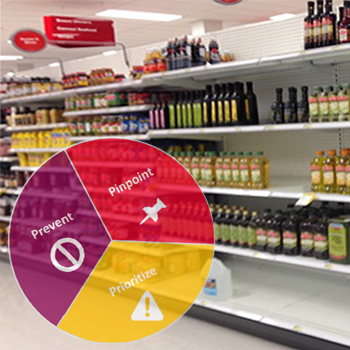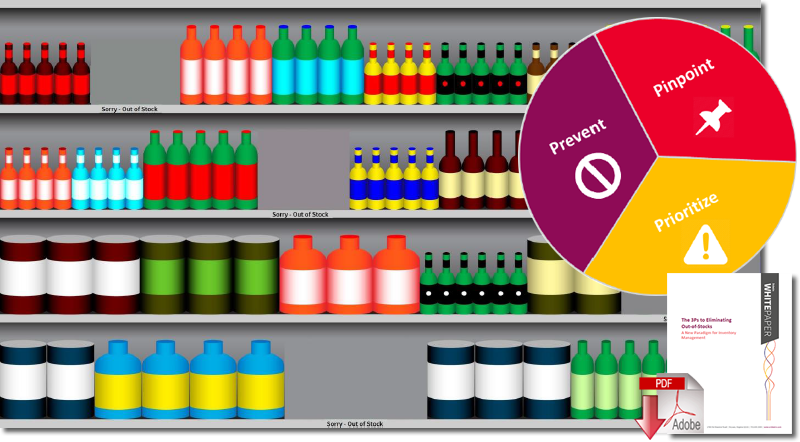The Problem with Traditional Inventory Management

Traditional inventory systems have always focused on improving forecasting, while the forecast is only a small part of the overall inventory management problem, most of the issues occur at the retail store shelf, which aren’t included in forecasts.
With out-of-stocks representing both a significant cost and a reputational concern, inventory management continues to be a thorn in the side of Consumer Packaged Goods (CPG) companies.
The reason? Traditional inventory systems have always focused on improving forecasting, while the forecast is only a small part of the overall inventory management problem.
Most of the issues occur at the retail store shelf, which aren’t included in forecasts.
A new paradigm is needed – one which brings all factors into play, and which enables a proactive approach to solving inventory problems before they occur.
Traditional Inventory Management
Traditional inventory systems attempt to solve the inventory management dilemma through better forecasting, improvements in the order point / order quantity process, or by adjusting safety stock levels.
However, order quantities, safety stock and lead time represent only a minority of the sources of inventory problems.
Many inventory problems are the result of poor execution, poor communication, and / or poor decision making.
Poor execution is common at all levels of the supply chain and starts at the store level. For example:
- Product makes it to the store but doesn’t make it to the shelf.
- Promotional displays or inventory make it to the store but not to the floor.
- Product is put on the wrong truck at a distribution center, sent to the wrong store, or is late to a distribution center.
Poor communication is common both within and across supply chain functions, and takes a particular toll in data analysis and collaboration. Analysts, category managers, sales managers and supply chain personnel look at problems in different ways and focus on different aspects of them. Getting insights from data is often a complex process for CPG data analysts, making collaboration difficult.
Poor decision-making is endemic at all levels of the supply chain, and is often the result of both poor execution and poor communication. Quite often poor decisions are made because the decision maker doesn’t know where to focus. There are so many different SKUs in so many different stores, from so many different distribution centers, in so many different locations in the stores, under so many different conditions. Consequently, shortcuts are almost always taken, which may compound the problem or lead to new ones.
Poor execution, communication and decision making, coupled with “advanced” inventory management systems leads to a vicious cycle, ultimately reducing sales, profit margins and customer loyalty.
A Virtuous Cycle in Inventory Management
Above, we outlined some of the issues with traditional inventory management. In particular, that poor execution, communication and decision-making in inventory management contribute to a vicious cycle of declining sales, margins and customer loyalty.
To address this vicious cycle, the CPG supply chain needs a system to identify and correct problems before they occur. This requires monitoring of many different genres of information – POS, shipments, orders, forecasts, forecast errors, on-hand inventory, inventory position, number of stores selling, etc. – and separating the signal from the noise to identify deviations from expected levels.
Let us explore how to create a virtuous cycle:
- PINPOINT service-level exceptions in the systems,
- PRIORITIZE which need immediate attention based on potential impact to the business, and
- PREVENT issues from reoccurring again in the future.
To implement this approach, a system is needed to alert users to what needs attention, and enable them to quickly resolve issues. It should help users identify patterns of exceptions and support collaboration to define and implement prevention mechanisms, using levers not limited to safety stock, forecasting, and ordering algorithms. This is actually the supply chain management implementation of business process integration.
Advanced inventory management solutions are discussed within the vague context of multi-echelon inventory systems or warehouse locations. But where do stock-outs hurt the most in terms of lost revenue? At the retail shelf. To demonstrate the value of the Pinpoint-Prioritize-Prevent approach, here is an example using on-shelf availability (OSA).
Example: Managing Inventory for On-Shelf Availability
Begin with customizing the alert triggers you want to PINPOINT. Users create a set of business rules to identify OSA risks and issues, assigns stores and item groups to the set of rules, and enables algorithms to process the rules.
Next is the PRIORITIZE stage. Designated individuals receive OSA alerts based on analysis of data and their defined business rules, so immediate issues can be resolved at the store or DC level. Users drill into the data to make sense of trends and patterns, and quantify the value of revenue at risk to determine which issue to resolve first.
Finally, the PREVENT stage identifies the root-cause drivers of the issues to eliminate future exceptions. At first, such a system is likely to generate many exceptions. As underlying problems are addressed, fewer exceptions will be generated – capturing more potentially lost sales.
Conclusion
By implementing the PINPOINT-PRIORITIZE-PREVENT paradigm in inventory management, CPG companies can better orchestrate their supply chain by optimizing execution, communication, and decision-making processes – using consumer demand as the key driver.
When inventory is driven by actual demand, in addition to forecast, the supply chain operates at greater efficiency and at increased profit margins.
CPG companies that fail to take an agile approach to inventory management may continue to struggle with on-shelf availability, and may find that consumers (and retailers) look elsewhere for the products they want.
Article Topics
Orchestro News & Resources
E2open Acquires Analytics Leader Orchestro How Demand Sensing Mitigates Crisis Situations The State of Inventory Management - 2015 The 3Ps to Eliminating Out-of-Stocks: A New Paradigm for Inventory Management The Problem with Traditional Inventory ManagementLatest in Supply Chain
Ask an Expert: How Shippers Can Prep for Hurricane Season Apple Accused of Multiple Human Rights Violations South Korea Finally Overtakes China in Goods Exported to U.S. UPS Struggles in First Quarter With Steep Earnings Decline How Supply Chains Are Solving Severe Workplace Shortages SAP Unveils New AI-Driven Supply Chain Innovations How Much Extra Will Consumers Pay for Sustainable Packaging? More Supply Chain













